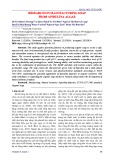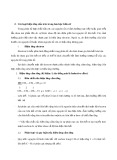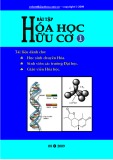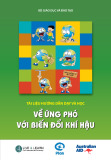
ISSN: 2615-9740
JOURNAL OF TECHNICAL EDUCATION SCIENCE
Ho Chi Minh City University of Technology and Education
Website: https://jte.edu.vn
Email: jte@hcmute.edu.vn
JTE, Volume 19, Issue 03, 2024
15
Impact of Choline Chloride and Organic Acid-Based Deep Eutectic Solvents on
the Extraction of Bioactive Compounds from Grape Pomace
Thao Thi Thanh Nguyen1, Viet Bao Nguyen1, Tuyen Chan Kha1, Hoang Van Chuyen2*
1Nong Lam University, Ho Chi Minh City, Vietnam
2Ho Chi Minh City University of Technology and Education, Vietnam
*Corresponding author. Email: chuyenhv@hcmute.edu.vn
ARTICLE INFO
ABSTRACT
Received:
09/04/2024
The objective of this study was to determine the impact of the extraction
conditions on the extraction yield of bioactive compounds from grape
pomace using choline chloride and organic acid-based deep eutectic
solvents (DES). Three different types of DES were used, including choline
chloride-lactic acid, choline chloride-malic acid, and choline chloride-
citric acid. The effect of the ratios of hydrogen bond acceptor to hydrogen
bond donor (2:1, 1:1, 1:2, 1:3), the water addition in the DES (10–35%),
the solid-to-solvent ratio (1/15–1/30 (w/w)), and extraction time (1.5–4
hours) on extraction were also investigated. The results showed that the
highest total extraction yield was obtained using a DES based on choline
chloride and lactic acid with a ratio of 1:2, 20% water, a solid-to-solvent
ratio of 1/25 (w/w), and an extraction time of 2.0 hours. Under the best
extraction conditions, the total phenolic content (TPC), total saponin
content (TSC), and proanthocyanidin content (PAC) of the extract from
grape pomace were found to be 42.53 ± 0.52 mg GAE/g DW, 101.43 ±
1.22 mg AE/g DW, and 17.11 ± 0.18 mg CE/g DW, respectively.
Revised:
30/05/2024
Accepted:
13/06/2024
Published:
28/06/2024
KEYWORDS
Bioactive compounds;
Choline chloride;
Deep eutectic solvents;
Grape pomace;
Organic acid.
Doi: https://doi.org/10.54644/jte.2024.1569
Copyright © JTE. This is an open access article distributed under the terms and conditions of the Creative Commons Attribution-NonCommercial 4.0
International License which permits unrestricted use, distribution, and reproduction in any medium for non-commercial purpose, provided the original work is
properly cited.
1. Introduction
The wine industry is growing rapidly, followed by a steady increase in the number of grape pomace,
which accounts for about 15–20% of the total weight of grapes (about 7 million tons), including skins
and seeds [1]. These grape pomaces are usually unused and discarded. This has created significant
economic and environmental concerns. The problem dealing with excess solid waste over the years has
caused many environmental problems, such as water pollution, soil degradation, and air pollution.
Nowadays, these grape pomaces are frequently used by wineries as fertilizers or animal feeds [2], and
occasionally they are sold to biogas plants for the production of renewable energy [3]. Grape pomaces
are utilized to make ethanol and organic acids, such as tartaric acid, malic acid, and citric acid. It has
been reported that in both red and white grape pomaces, significant amounts of bioactive compounds
are retained after winemaking, with an estimated 70% of the phenolic content remaining in the grape
pomace [4]. The recovery of these bioactive compounds is also economically viable and is a direction
for the sustainable development of wine and juice production systems for countries.
The development of alternative green solvents has received a lot of attention to better protect human
health and the environment from the risks associated with the use of toxic solvents. Deep eutectic
solvents (DESs), which are Generally Recognized as Safe solvents (GRAS), are formed by the
combination of hydrogen bond acceptor (HBA) and hydrogen bond donor (HBD). Due to the hydrogen
bonding interactions established between DES molecules and bioactive compounds, DESs are solvents
that can dissolve bioactive compounds [5]. Many studies have shown the effectiveness of DESs in the
extraction of bioactive compounds such as phenolic acids, proanthocyanidins, and saponins [6]-[8]. The
types of DES used for extraction depend on the type of raw material and target compounds. DES solvent
systems are often created by combining HBA (inorganic salts such as quaternary ammonium,
tetralkylammonium, or phosphonium salts; amino acids such as alanine, proline, glycine, or betaine)
with HBD (organic acids, alcohols, amides, or carbohydrates) [5], [9]. Organic acids are common, safe,
and inexpensive substances, which makes them an attractive choice as hydrogen bond donors for DES.

ISSN: 2615-9740
JOURNAL OF TECHNICAL EDUCATION SCIENCE
Ho Chi Minh City University of Technology and Education
Website: https://jte.edu.vn
Email: jte@hcmute.edu.vn
JTE, Volume 19, Issue 03, 2024
16
In addition, DES systems produced by combining choline chloride with HBD from various organic acids
have been reported to have high extraction efficiency on plant materials [5], [10].
Although DES systems have been used for extraction bioactive compounds from pomace of grape
varieties which mainly used in wine grape varieties, the Red Cardinal grape variety (a table grape
variety) has not been studied for the recovery of bioactive compounds. In addition, a research by Dwyer
et al. (2014) [4] used DES based on combining choline chloride with alcohol and organic acids with
high viscosity which is suitable for applying in oleogel and emulsions. In contrast, the DES based on
combining choline chloride with organic acids has low viscosity and is suitable for convenient
applications like spray drying. Thus, this study was conducted to deal with large amounts of by-products
from the production of juice and wine from local producers, which mostly used as feeds for goats and
sheep, in Ninh Thuan province (Vietnam). The application of DES (formed by choline chloride with
organic acids) to extract bioactive compounds from Red Cardinal grape pomace can be a sustainable
development in the future.
2. Materials and Methods
2.1. Materials
2.1.1. Grape pomace
Red Cardinal grape pomace (GP) was collected from Ba Moi Company (Ninh Thuan province,
Vietnam). Grape pomace was pretreated following the method outlined by [6]. The GP (separated
branches and seeds) was heat-pump dried at 40°C (moisture content ≤ 10%), ground into powder (≤ 0.5
mm). Grape pomace powder was stored at -18 °C for further experiments.
2.1.2. Standards and reagents
Choline chloride (Himedia, India), vanillin (Himedia, India), and Folin-Ciocalteau reagent (Himedia,
India), citric acid (Jiangsu Guoxin Union Energy, China), lactic acid (Xiong, China), malic acid (Isegen,
South Africa), sulfuric acid (Xilong, China), hydrochloric acid (Xilong, China), sodium carbonate
(Xilong, China), sodium nitrite (Guangdong guanghua, China), aluminum chloride (Xilong, China), and
sodium hydroxide (Xilong, China) were obtained from SBC Trading and Service Co., Ltd, Ho Chi Minh
City, Vietnam. The standards were gallic acid (Himedia, India), aescin (Sigma-Aldrich, USA), and
catechin (Thermo Fisher Scientific, UK).
2.2. Methods
2.2.1. Preparation of DESs
Choline chloride (HBA) was mixed with the appropriate amount of lactic, malic, or citric acids as
the HBD at different ratios (choline chloride: lactic acid (ChCl–LA) = 1:2, choline chloride: malic acid
(ChCl–MA) = 1:1, choline chloride: citric acid (ChCl–CA) = 2:1) [11], [12]. Then, water was added to
DESs (30%). The mixtures were stirred with a magnetic stirrer at 80°C [13] at 260 rpm for 1.5 hours.
The mixture formed a clear liquid and remained liquid after about 24 hours at ambient temperature.
2.2.2. Effect of extraction conditions on bioactive compounds from grape pomace
DESs were prepared with different ratios of hydrogen bond acceptor to hydrogen bond donor (2:1,
1:1, 1:2, and 1:3). Then, an amount of GP powder was mixed with DESs according to the different solid-
to-solvent ratios (1/15, 1/20, 1/25, and 1/30 (w/w)). The water additions in DESs were 10, 15, 20, 25,
30, and 35%. The mixture was stirred using a magnetic stirrer at 260 rpm for different extraction times
(1.5, 2.0, 2.5, 3.0, 3.5, and 4 hours) at an extraction temperature of 30 ºC. Finally, the mixture was
centrifuged in a refrigerated centrifuge at 6,000 rpm, at 4 °C for 10 min. The supernatant extract was
collected and further analyzed.
2.2.3. Determination of TPC, TSC, and PAC
TPC was analyzed using the method outlined by Škulcova, et al. [14] with modifications. For tested
samples, add 0.5 mL of each diluted extract to the test tube. Add 0.5 mL of 10% Folin-Ciocalteu’s
reagent and 2.5 mL of 20% Na2CO3 to each test tube and shake well. Leave the reaction tubes at ambient

ISSN: 2615-9740
JOURNAL OF TECHNICAL EDUCATION SCIENCE
Ho Chi Minh City University of Technology and Education
Website: https://jte.edu.vn
Email: jte@hcmute.edu.vn
JTE, Volume 19, Issue 03, 2024
17
temperature for 1 hour, then measure the absorbance of the solution at 765 nm. TPC was expressed as
gallic acid equivalent (GAE) per g of dry weight of GP (mg GAE/g DW).
TSC was determined according to the method of Tan, et al. [15]. The extract (0.3 mL) was mixed
with 8% (w/v) vanillin solution (0.3 mL) and 72% (v/v) sulfuric acid (3 mL) and then incubated at 60°C
for 15 min. The mixture was then cooled for 10 min and was measured the absorbance of the solution
at 560 nm. TSC was expressed in mg aecsin equivalent per g of dry weight of GP (mg AE/g DW).
PAC was estimated according to the method of Li, et al. [16] with modifications. The extract (0.5
mL) was mixed with 0.3 mL of 4% (w/v) vanillin solution and 1.5 mL of 36% HCl. The mixture was
then incubated at room temperature for 15 min. Measure the absorbance at 500 nm. PAC is expressed
in mg catechin equivalents per g of dry weight of GP powder (mg CE/g DW).
The Total is computed by summing the individual quantities of TPC, TSC, and PAC.
2.2.4. Statistical analysis
Each single-factor experiment was repeated three times, and the experimental results were presented
as the mean ± standard deviation. To analyze differences between the means, an analysis of variance
(ANOVA) was performed, followed by the least significant difference (LSD) using JMP Pro 13.0
software with p <0.05.
3. Results and Discussion
3.1. The effect of DESs type on the extraction of bioactive compounds
Each type of DES has physicochemical characteristics leading to different extraction efficiency.
Therefore, for the extraction process of bioactive compounds, choosing the suitable DES type for the
specific raw material and target compound is one of the most important factors. In this study, the effect
of three DESs (choline chloride: lactic acid (ChCl–LA) = 1:2, choline chloride: malic acid (ChCl–MA)
= 1:1, choline chloride: citric acid (ChCl–CA) = 2:1) on the extraction of bioactive compounds from
grape pomace was investigated. The fixed factors included solid-to-solvent ratio (1/20, w/w), water
addition (30%), extraction temperature (30 ºC), and extraction time (1.5 hours). The result is shown in
Figure 1.
Figure 1. The effect of DES type on the extraction of bioactive compounds from grape pomace
Distinct letters within the same parameters indicated statistically significant differences between extracts
obtained by different DES types (p ≤ 0.05).
c
ab
C
AB
c' a' b'
C'
A'
B'
0
20
40
60
80
100
120
140
ChCl-CA ChCl-LA ChCl-MA
mg/g DW
DES type
TPC TSC PAC Total

ISSN: 2615-9740
JOURNAL OF TECHNICAL EDUCATION SCIENCE
Ho Chi Minh City University of Technology and Education
Website: https://jte.edu.vn
Email: jte@hcmute.edu.vn
JTE, Volume 19, Issue 03, 2024
18
Statistical results showed that there was a significant difference in the ability of the extraction
solvents to extract bioactive compounds from grape pomace (p < 0.05). Among the DESs, the one based
on choline chloride and lactic acid (ChCl–LA) gave the highest extraction yield. This is evident in the
total extraction yield, which amounted to 131.99 ± 0.97 mg/g DW, including TPC, TSC, and PAC of
the extract of 36.19 ± 0.55 mg GAE/g DW, 82.30 ± 1.03 mg AE/g DW, and 13.49 ± 0.24 mg CE/g DW,
respectively. These values were higher than those obtained with the other two solvents and had statistical
significance (p < 0.05). In general, the highest total extraction yield was monocarboxylic acid (lactic
acid), followed by dicarboxylic acid (malic acid) and tricarboxylic acid (citric acid). This result is similar
to previous studies in that the extraction efficiency of bioactive compounds using ChCl–LA was higher
than that of ChCl–MA and ChCl–CA [10], [17]. Many studies have also shown that when the molecular
structure of HBD has more hydroxyl (OH) and/or carboxyl (COOH) groups, the recovery of bioactive
compounds is reduced [8]. In solid-liquid extraction, the viscosity of the solvent is important for
practical application. ChCl–LA showed higher extraction efficiency than ChCl–MA and ChCl–CA
possibly due to the difference in their viscosities. The DES with more hydroxyl group (OH), carboxyl
group (COOH) in the molecular structure has a higher viscosity. According to Crespo, et al. [18],
viscosity decreases as the number of functional groups decreases: citric acid has a higher viscosity,
followed by malic acid, then lactic acid. The high viscosity of ChCl–MA and ChCl–CA will restrict the
mobility of target compounds inside DES thereby reducing extraction efficiency. Therefore, the DES
generated by choline chloride and lactic acid, has the lowest viscosity, and was more suitable for the
bioactive compound extraction from grape pomace than ChCl–MA and ChCl–CA.
3.2. The effect of HBA: HBD ratio on the extraction of bioactive compounds
Determining the appropriate HBA: HBD ratio is important to improve the extraction rate of total
bioactive compounds. To investigate the effect of the HBA: HBD ratio of ChCl–LA on the extraction
of bioactive compounds from grape pomace, the extraction processes were performed with DESs of
different choline chloride: lactic acid ratios from 2:1 to 1:3. The fixed factors included solid-to-solvent
ratio (1/20, w/w), water addition (30%), extraction temperature (30 ºC), and extraction time (1.5 hours).
The result is shown in Figure 2.
Figure 2. The effect of HBA: HBD ratio on the extraction of bioactive compounds from grape pomace
Distinct letters within the same parameters indicated statistically significant differences between extracts
obtained by DES with different HBA: HBD ratios (p ≤ 0.05).
cbad
DC
BA
b' a' a' b'
D' C'
A' B'
0
20
40
60
80
100
120
140
2:1 1:1 1:2 1:3
mg/g DW
HBA: HBD ratio (w/w)
TPC TSC PAC Total

ISSN: 2615-9740
JOURNAL OF TECHNICAL EDUCATION SCIENCE
Ho Chi Minh City University of Technology and Education
Website: https://jte.edu.vn
Email: jte@hcmute.edu.vn
JTE, Volume 19, Issue 03, 2024
19
Statistical results showed that the difference in the ratio of choline chloride and lactic acid
significantly affected the ability to extract bioactive compounds in grape pomace (p < 0.05). As can be
seen in Figure 2, ChCl–LA with a ratio of 1:2 gave the highest extraction yield. The TPC, TSC, and
PAC of the extract were 35.44 ± 0.40 mg GAE/g DW, 81.22 ± 0.76 mg AE/g DW, and 13.66 ± 0.18 mg
CE/g DW, respectively. The total extraction yield increased with a ratio range of 2:1 to 1:2 (w/w). That
corresponded to the decrease in choline chloride and increased lactic acid in the DES system. The total
extraction yield decreased when the choline chloride: lactic acid ratio changed from 1:2 to 1:3 (w/w).
This phenomenon is similar to previously reported results [13], [19]. The ability to extract some
bioactive compounds with DES is attributed to hydrogen bonding interactions between molecules of
DES and bioactive compounds. The decrease in extraction yield may be due to a decrease in the amount
of choline chloride (HBA in the DES system), leading to a decrease in hydrogen bond strength because
the chloride anion is a proportion of hydrogen bond receptors [13]. Furthermore, lactic acid is acidic.
Because of the advantageous partially acidic environment for phenolic compound extraction, extraction
efficiency rises when the HBA-HBD ratio decreases. However, high acid causes DES's physicochemical
characteristics, such as pH and polarity, to alter significantly, which may lower extraction efficiency
[20]. Therefore, the HBA: HBD ratio of 1:2 was selected for the further experiments.
3.3. The effect of water addition on the extraction of bioactive compounds
Despite their potential, one of the limitations of DES is their high viscosity. Therefore, an appropriate
amount of water is often added with a deep eutectic solvent to improve this drawback. Accordingly, this
experiment focused on the influence of different water additions on the extraction performance of ChCl–
LA (HBA: HBD ratio of 1:2). The extraction processes were performed with ChCl–LA of different
water additions (10–35%). The fixed factors included the solid-to-solvent ratio (1/20, w/w), extraction
temperature (30 ºC), and extraction time (1.5 hours). The effect of water addition on the extraction of
bioactive compounds is shown in Figure 3.
Figure 3. The effect of water addition on the extraction of bioactive compounds from grape pomace
Distinct letters within the same parameters indicated statistically significant differences between extracts
obtained by DES with different water addition (p ≤ 0.05).
Statistical results showed that the difference in water addition in ChCl–LA affected the ability to
extract bioactive compounds in grape pomace (p < 0.05). As shown in Figure 3, the total extraction yield
increased with the increase in water content added to ChCl–LA from 10% to 20%. In particular, the
ChCl–LA with 20% water addition gave the highest extraction yield. The TPC, TSC, and PAC of the
dcbbc abc
E
D
ABBC
d' c' a' b' b' c'
F'
E'
A' C' B' D'
0
20
40
60
80
100
120
140
10 15 20 25 30 35
mg/g DW
Water addition (%)
TPC TSC PAC Total











![Tài liệu Vi sinh vật môi trường [Mới nhất]](https://cdn.tailieu.vn/images/document/thumbnail/2025/20251123/ngkimxuyen/135x160/21891763953413.jpg)
![Sổ tay truyền thông Phân loại chất thải rắn sinh hoạt trên địa bàn tỉnh Quảng Nam [Chuẩn nhất]](https://cdn.tailieu.vn/images/document/thumbnail/2025/20251114/kimphuong1001/135x160/1701763094001.jpg)


![Quản lý chất thải nguy hại: Sổ tay Môi trường [Chuẩn nhất]](https://cdn.tailieu.vn/images/document/thumbnail/2025/20251029/kimphuong1001/135x160/9011761720170.jpg)









